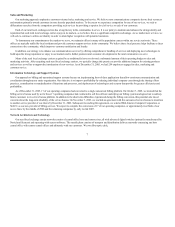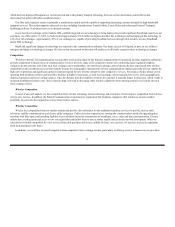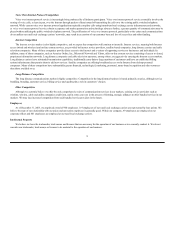FairPoint Communications 2005 Annual Report Download - page 19
Download and view the complete annual report
Please find page 19 of the 2005 FairPoint Communications annual report below. You can navigate through the pages in the report by either clicking on the pages listed below, or by using the keyword search tool below to find specific information within the annual report.
based upon our directors’ current assessment of our business and the environment in which we operate, and that assessment could change based on
competitive or technological developments (which could, for example, increase our need for capital expenditures) or new growth opportunities. In addition,
future dividends with respect to shares of our common stock, if any, will depend on, among other things, our cash flows, cash requirements, financial
condition, contractual restrictions, provisions of applicable law and other factors that our board of directors may deem relevant. Our board of directors may
decrease the level of dividends provided for in the dividend policy or entirely discontinue the payment of dividends. Our credit facility contains significant
restrictions on our ability to make dividend payments. There can be no assurance that we will generate sufficient cash from continuing operations in the
future, or have sufficient surplus or net profits, as the case may be, under Delaware law, to pay dividends on our common stock in accordance with the
dividend policy. If we were to use borrowings under our credit facility’s revolving facility to fund dividends, we would have less cash available for future
dividends. The reduction or elimination of dividends may negatively affect the market price of our common stock.
We may not retain a sufficient amount of cash to finance a material expansion of our business, or to fund our operations consistent with past levels of
funding in the event of a significant business downturn. In addition, because a substantial portion of cash available to pay dividends will be distributed to
holders of our common stock under our dividend policy, our ability to pursue any material expansion of our business, including through acquisitions or
increased capital spending, will depend more than it otherwise would on our ability to obtain third party financing. There can be no assurance that such
financing will be available to us at all, or at an acceptable cost.
Our ability to consummate acquisitions and to make payments on our indebtedness will depend on our ability to generate cash flow from operations in
the future. This ability, to a certain extent, is subject to general economic, financial, competitive, legislative, regulatory and other factors that are beyond our
control. There can be no assurance that our business will generate sufficient cash flow from operations or that future borrowings will be available to us in an
amount sufficient to enable us to pay our indebtedness or to fund our other liquidity needs.
A significant amount of our cash flow from operations will be dedicated to capital expenditures and debt service. In addition, we currently expect to
distribute a significant portion of our cash flow to our stockholders in the form of quarterly dividends. As a result, we may not retain a sufficient amount of
cash to finance growth opportunities, including acquisitions, or unanticipated capital expenditures or to fund our operations. In addition, if we reduce capital
expenditures, the regulatory settlement payments we receive may decline.
Borrowings under our credit facility bear interest at variable interest rates. Accordingly, if any of the base reference interest rates for the borrowings under
our credit facility increase, our interest expense will increase, which could negatively impact our ability to pay dividends on our common stock. On
February 8, 2005, we entered into three interest rate swap agreements, with notional amounts of $130 million each, to effectively convert a portion of our
variable rate interest exposure to fixed rates ranging from 5.76% to 6.11%. These swap agreements expire beginning December 31, 2007 through December 31,
2009. On April 7, 2005, we entered into two additional interest rate swap agreements, one with the notional amount of $50.0 million to effectively convert a
portion of our variable rate interest exposure to a fixed rate of 6.69% beginning on April 29, 2005 and ending on March 31, 2011, and one with the notional
amount of $50.0 million to effectively convert a portion of our variable rate interest exposure to a fixed rate of 6.72% beginning on June 30, 2005 and ending
on March 31, 2012. As a result of these swap agreements, as of
17
























